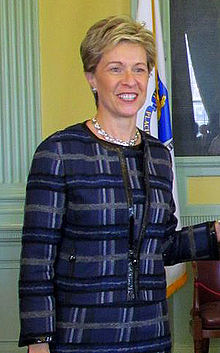Suzanne Bump
| Suzanne Bump | |
|---|---|
 |
|
| 22nd Auditor of Massachusetts | |
|
Assumed office January 19, 2011 |
|
| Governor |
Deval Patrick Charlie Baker |
| Preceded by | Joseph DeNucci |
| Massachusetts Secretary of Labor and Workforce Development | |
|
In office 2007–2009 |
|
| Governor | Deval Patrick |
| Preceded by | Gayl Mileszko |
| Succeeded by | Joanne Goldstein |
| Member of the Massachusetts House of Representatives from the 5th Norfolk district |
|
|
In office January 1985 – January 1993 |
|
| Preceded by | Elizabeth Metayer |
| Succeeded by | Joseph Sullivan |
| Personal details | |
| Born |
February 18, 1956 Weymouth, Massachusetts, U.S. |
| Political party | Democratic |
| Spouse(s) | Paul McDevitt (m. 1980; d. 2016) |
| Children | 2 |
| Education |
Boston College (BA) Suffolk University (JD) |
Suzanne M. Bump (born February 18, 1956) is the current Massachusetts State Auditor, the first female elected to this role in the state’s history. She is a former State Representative and state Secretary of Labor and Workforce Development.
Bump was born on February 18, 1956 in Weymouth, Massachusetts. Her father was a funeral director and her mother was a homemaker. She attended Cardinal Spellman High School, received her A.B. from Boston College, and received her J.D. from Suffolk University Law School. According to her campaign biography, she grew up in Whitman and moved to Braintree after college. She later moved to Great Barrington.
She started her career off as a legislative aide. From 1985 to 1993 she was the state representative for the 5th Norfolk district, She served on the Commerce and Labor Committee, and she spent two years as Chairman of that Committee. From 2007 to 2009 she was secretary of labor in the administration of Governor Deval Patrick.
Prior to Suzanne's leading the Massachusetts Executive Office of Labor and Workforce Development, unemployment claims were handled on an antiquated processing system. She was noted for securing funding and overseeing the roll out of modern telephone and computerized claims systems. In 2008, Bump announced a regional partnership program that provided new funds to help ex-offenders achieve successful re-entry into communities. The program focused on high crime communities by both providing preventative public safety measures and acting as an economic boost to the regions that received funding.
...
Wikipedia
